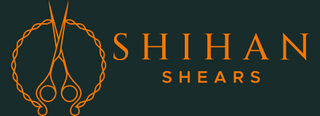Hairstylists and barbers face risks like wrist pain, carpal tunnel, and posture-related injuries due to repetitive motions and poor ergonomics. Here's how to stay safe and protect your career:
- Choose ergonomic shears: Offset, crane, or swivel handles reduce wrist and shoulder strain.
- Maintain good posture: Stand straight, adjust the client’s chair, and use a saddle stool for support.
- Care for your shears: Clean, oil, and sharpen them regularly to avoid extra force while cutting.
- Take breaks and stretch: Simple wrist and hand exercises can prevent strain injuries.
- Use protective gear: Wrist braces and finger guards provide extra support during long sessions.
Shear Ergonomics for Hairdressers - Preventing Carpal Tunnel
Choosing and Holding Shears Correctly
Using the right shears and handling them properly can help prevent issues like carpal tunnel syndrome. Let’s break down how different designs and techniques can make a big difference in safety and comfort.
Finding the Right Shear Design
Shears come in various handle designs, each offering unique ergonomic advantages. Offset handles are great for keeping your wrist in a natural position, reducing strain. Crane handles are perfect for stylists dealing with neck and shoulder discomfort, as they encourage better posture. If you're willing to practice, swivel handles allow you to adjust the thumb position for a more customized grip.
| Handle Type | Best For | Safety Benefit |
|---|---|---|
| Offset | General use | Natural wrist positioning |
| Crane | Neck/shoulder issues | Promotes better posture |
| Swivel | Experienced users | Adjustable grip for comfort |
| Classic | Traditional stylists | Familiar, straightforward control |
Shear length also plays a key role. Shorter shears (4.5–6 inches) are ideal for detailed work like point cutting, while longer shears (6–7⁄8 inches) help you cut larger sections of hair, minimizing repetitive movements. A 6.0-inch shear, for example, strikes a great balance between precision and efficiency.
Correct Finger Position and Tension
Even the best shears won’t perform well without proper finger placement. Place your thumb in the larger hole, your ring finger in the smaller one, and rest your pinky on the tang for stability. If you feel discomfort or fatigue, it’s a sign that something’s off - either the fit isn’t right, or your technique needs adjustment. Rubber finger inserts, which cost about $2 , can improve grip and comfort significantly.
Shear tension is another factor to get right. The blades should cut smoothly without requiring too much force, which helps prevent hand and wrist strain. When trying out new shears, check how evenly the weight is distributed and how they feel in your hand. Practicing basic cuts can help you get comfortable with your form and ensure you’re using the shears correctly.
Body Position and Movement
In addition to selecting the right shears, maintaining proper body positioning plays a key role in avoiding injuries and ensuring a long, healthy career.
Keeping Good Posture
Handling your shears correctly is important, but so is aligning your body to minimize strain. Stand with your feet shoulder-width apart, engage your core, and align your head, shoulders, hips, and feet for a straight, balanced posture.
Adjusting the client’s chair height can make a big difference in your body mechanics:
| Client Position | Body Mechanics | Injury Prevention Benefit |
|---|---|---|
| Eye Level | Straight spine, relaxed shoulders | Eases neck tension |
| Too Low | Causes hunching, neck bending | Adds strain to the upper back |
| Too High | Lifts shoulders, overworks arms | Leads to shoulder fatigue |
Shift your weight between your feet occasionally and take short breaks every 30 minutes to stretch and reset your posture.
"Correcting your shoulder positioning is almost as simple as the advice you might have gotten from your mother: 'sit up straight and pull your shoulders back.'" - Theodore Wallis, The Muscle Mechanics Owner
Working with a Stylist Stool
Saddle stools are designed to support natural spine alignment while keeping your chest open and your back relaxed . Choose a stool with adjustable features to ensure proper support.
When using a cutting stool:
- Work at eye level to avoid neck strain.
- Keep your feet flat for stability.
- Opt for a stool with wheels to move easily.
- Pick one with balance features to engage your core.
Modern ergonomic stools, especially those with saddle-style seats, encourage an open hip angle, promoting better posture naturally . This design allows you to maintain proper form while staying mobile around your client.
Position yourself directly in front of or parallel to the section you're cutting to avoid overreaching. Take a small step back when necessary to prevent crowding the client, which can lead to arm and wrist strain . These small adjustments work hand-in-hand with earlier techniques to help you avoid injuries.
sbb-itb-a50b05d
Shear Care and Safety Rules
Taking care of your shears goes hand-in-hand with using them properly. Regular maintenance not only keeps your tools in top condition but also helps prevent accidents and ensures they last longer.
Basic Safety Guidelines
Safe use of shears starts with careful handling and staying alert. Always cut away from your body to avoid injuries, and stay focused - this isn’t the time for casual conversations or distractions. When handing tools to someone, place them on a clean surface instead of passing them directly.
| Safety Practice | Why It Matters | How to Do It |
|---|---|---|
| Directional Cutting | Reduces injury risk | Always cut away from your body |
| Tool Transfer | Prevents accidents | Lay tools down with the handle facing the recipient |
| Storage Position | Protects the blades | Store with sharp edges facing away in designated slots |
| Usage Focus | Minimizes distractions | Avoid unnecessary conversations while working |
Handle your shears with care - dropping them can damage the blades, making them less effective or even unsafe to use.
Proper maintenance is just as important as safe handling.
Maintenance Schedule
A simple daily routine can keep your shears in excellent condition:
- After each client: Clean shears with a non-abrasive cleaner and dry them thoroughly before sanitizing.
- End of the day: Apply professional-grade shear oil to the center joint to prevent rust and stiffness.
"Daily oiling of shears will also keep them in tip-top shape which will extend their useful life and keep them in great operational order. Many hairstylists and barbers oil their shears at the end of the day when their scissors won't be used for many hours. The haircutting shear oil keeps them from rusting and getting stiff, allowing for easy, smooth, efficient and controlled haircutting."
Don’t forget to have your shears professionally sharpened on a regular basis. Dull blades can bend hair instead of cutting it cleanly, which not only affects results but also puts extra strain on your hands .
When storing shears, keep them in a dry, stable environment away from heat and direct sunlight. Avoid humid areas and don’t use rubber bands to secure them, as these can harm the blades . Store each pair separately to prevent them from coming into contact with other tools. A little care goes a long way in keeping your shears performing well and ensuring a safe, injury-free career.
Daily Injury Prevention Steps
Taking care of your tools and maintaining good posture are crucial, but your daily habits play an equally important role in protecting your health and minimizing the risk of workplace injuries.
Rest and Exercise
Regular breaks combined with specific hand and wrist exercises can help prevent issues like RSIs, Carpal Tunnel Syndrome, and Tendonitis . Incorporate short breaks between clients to try exercises like these:
- Inner Wrist Massage: With your hand palm-up, use your opposite thumb to massage the crease of your wrist for 10–15 seconds.
- Outer Wrist Stretch: Extend your arm with your palm facing down, interlock your fingers with the other hand, and gently pull until you feel a stretch. Repeat five times.
- Finger Stretches: Gently pull back each finger for about 2 seconds to maintain flexibility.
- Wrist Extension/Flexion: Stretch your arm out and alternate between extending and flexing your wrist, holding each position for 1–2 seconds.
For relief during the day, switch between heat therapy to relax stiff hands and cold therapy to reduce swelling .
Protective Equipment
Using the right protective gear can lower your chances of injury. For example, the Dr. Arthritis Premium Carpal Tunnel Brace ($19.95) provides solid support during long cutting sessions . Look for finger guards that fit securely but still allow free movement . Remember to clean your gear daily, following the manufacturer’s instructions, and take off wrist supports during breaks to promote light movement and prevent muscle weakening .
Mixed Cutting Methods
Switching up your cutting techniques throughout the day can help reduce repetitive stress injuries . Consider these approaches:
- Long Shear Techniques: For tasks like shear-over-comb or cutting with a comb, use tools like the Shihan Legacy Hair Shears Set to keep your arm in a natural position.
- Precision Work: When doing detailed work such as point cutting or palm-to-palm cutting, opt for shorter shears like the Zen Hair Cutting Shears to minimize wrist strain.
- Ergonomic Positioning: Adjust your client’s chair height to avoid awkward wrist angles. Keep your shoulders relaxed and avoid twisting your wrists, especially when working near the client’s face .
Building Safe Work Habits
Developing safe work habits is crucial for protecting your health and ensuring a long-lasting career. Regular maintenance, as outlined earlier, is key to both safety and performance .
"For a professional who uses shears all day in the salon, not paying attention to ergonomics is a mistake that can cost you your career." – Sensei Shears
Your workspace also plays an important role in maintaining safety. A well-ventilated, clutter-free salon reduces hazards and creates a better environment for everyone. When salon managers prioritize safety, it can boost staff morale and lower workplace stress, helping to support long-term success .
Here are a few essential practices to keep in mind:
- Use ergonomically designed shears, such as those with offset or swivel handles.
- Keep your tools clean and ensure they are properly tensioned.
- Take regular breaks away from chemical exposure.
- Wear protective gear suited for your tasks.
- Maintain an organized, hazard-free workspace.
These steps complement the ergonomic techniques and maintenance routines discussed earlier, helping you work smarter and safer.

